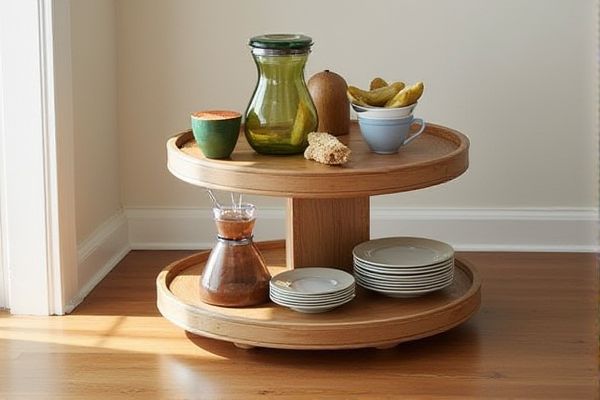
Choosing between a two-tier lazy Susan and a three-tier lazy Susan depends on your storage needs and available space; a two-tier design offers compact organization ideal for smaller kitchens, while a three-tier model provides enhanced vertical storage for maximizing pantry capacity. Explore the detailed comparison to determine which lazy Susan fits your kitchen setup and elevates your storage efficiency.
Table of Comparison
| Feature | Two-Tier Lazy Susan | Three-Tier Lazy Susan |
|---|---|---|
| Number of Tiers | 2 Levels | 3 Levels |
| Storage Capacity | Moderate | Higher |
| Height | Lower profile | Taller, requires more vertical space |
| Ideal For | Standard kitchen cabinets and countertops | Deep cabinets, pantry corners, maximizing vertical storage |
| Weight Capacity | Supports moderate weight | Supports heavier items with better weight distribution |
| Cost | Generally lower | Typically higher due to extra tier |
| Ease of Access | Simple to spin and access items | More items accessible, but may require slightly more effort to reach top tier |
Introduction to Lazy Susans
Two-tier lazy Susans offer compact storage with two rotating shelves, ideal for smaller cabinets and easy access to spices and condiments, enhancing kitchen organization. Three-tier lazy Susans provide increased vertical storage capacity, making them suitable for larger kitchens or pantry spaces by adding an extra shelf to accommodate more items without clutter. Both designs maximize corner cabinet usability but differ mainly in storage volume and spatial requirements.
Overview: Two-Tier vs Three-Tier Lazy Susan
Two-tier lazy Susans offer compact storage with two rotating levels, ideal for smaller cabinets or countertop spaces, providing easy access to frequently used items like spices or condiments. Three-tier lazy Susans expand storage capacity by adding an additional rotating shelf, perfect for larger kitchens needing organized space for pots, pans, and dry goods while maintaining accessibility. The choice between two-tier and three-tier models depends on kitchen size, storage needs, and the types of items to be organized efficiently.
Space-Saving Capabilities
A three-tier lazy Susan offers enhanced space-saving capabilities compared to a two-tier model by providing an extra layer for storage, allowing you to organize more items vertically within the same footprint. This additional tier maximizes cabinet or countertop space, making it ideal for kitchens with limited capacity. Choosing a three-tier lazy Susan can help optimize your storage efficiency while keeping frequently used items easily accessible.
Storage Capacity Comparison
A three-tier lazy Susan offers significantly greater storage capacity than a two-tier model, allowing for better organization and separation of items across multiple levels. While a two-tier lazy Susan typically holds fewer items, it provides easier access and is ideal for smaller spaces or limited storage needs. The extra tier in a three-tier lazy Susan maximizes vertical space, making it suitable for kitchens or pantries requiring efficient storage solutions for a variety of containers.
Ideal Uses for Two-Tier Lazy Susans
Two-tier lazy Susans are ideal for compact spaces such as small kitchens and cabinets, providing efficient storage for frequently accessed items like spices, condiments, and canned goods. Their smaller profile allows them to fit seamlessly under cabinets or in corner units, maximizing vertical storage without overwhelming the space. This design enhances organization and accessibility, making it perfect for everyday essentials in tight areas.
Ideal Uses for Three-Tier Lazy Susans
Three-tier lazy Susans offer increased vertical storage capacity, making them ideal for organizing kitchen essentials such as spices, canned goods, and small cookware in limited cabinet spaces. Their multi-level design maximizes easy access and visibility, perfect for crowded pantries or corner cabinets where space optimization is crucial. This tiered arrangement simplifies categorization and retrieval, enhancing efficiency during cooking and meal preparation.
Accessibility and Convenience
Two-tier lazy Susans offer enhanced accessibility by providing easy reach to frequently used items on two levels, reducing the need to bend or stretch inside cabinets. Three-tier lazy Susans increase convenience by maximizing storage capacity and organization, allowing users to separate items by category or size. While two-tier models are ideal for smaller spaces with quick access needs, three-tier units cater to kitchens requiring more comprehensive storage solutions without sacrificing accessibility.
Material and Design Options
Two-tier lazy Susans typically feature simpler designs with materials such as stainless steel, wood, or plastic, offering straightforward tiered storage for compact spaces. Three-tier lazy Susans often provide more elaborate design options, including adjustable shelves, glass inserts, and a variety of finishes like matte black metal or polished chrome, catering to larger storage needs and aesthetic versatility. Material choices in three-tier models emphasize durability and style, making them suitable for both kitchens and display purposes.
Pricing and Value Considerations
Two-tier lazy susans generally offer a more affordable price point, making them ideal for budget-conscious buyers seeking efficient cabinet organization. Three-tier lazy susans provide increased storage capacity and better visibility, delivering greater value for those willing to invest a bit more. Your choice depends on balancing initial cost with the enhanced functionality and space optimization you need.
Choosing the Right Lazy Susan for Your Needs
Choosing between a two-tier lazy Susan and a three-tier lazy Susan depends on available space and storage requirements. Two-tier models offer compact, accessible storage ideal for smaller kitchens or limited countertop areas, while three-tier lazy Susans maximize vertical space, providing increased capacity for organizing spices, condiments, or pantry items. Assessing kitchen layout and typical usage patterns ensures selecting the optimal tier design to enhance convenience and efficiency.
 homyna.com
homyna.com